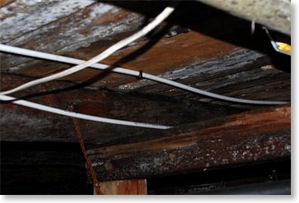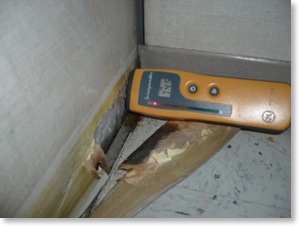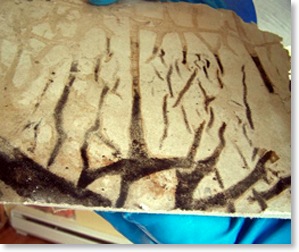Facts about Mould and Safety Tips
The Myth about Chlorine Bleach
US spelling - mold
Some companies advocate the use of Chlorine Bleach as a mould remover for remediation projects. We DO NOT use or recommend chlorine bleach [sodium hypochlorite] to kill mould or disinfect mouldy areas.
- Chlorine is a highly toxic gas and is one of the most commonly used chemical agents for household cleaning.
- Chlorine can cause, among other conditions, respiratory concerns.
- Chlorine is not an effective or permanent killer of mould or the mould spores and does not address the odours caused by mVOC's (volatile organic compounds) that are released by the live and dying mould.
- Chlorine bleach is too diluted to permanently kill mould unless the mould is sitting on top of a hard non-cellulose surface*.
- As chlorine constantly escapes through the plastic walls of its containers, it's effectiveness is further reduced by up to 50% in 90 days in a never opened container.
- Mould, by nature of the physiology, has a hyphae that extends out from the body of the mould cell. This hyphae can penetrate and intertwine into the fibers of the substrate, in this case, the dry wall or wood, microscopically piercing the surface of these items. The ion structure of the chlorine prevents it from penetrating into those same porous materials.
- The chlorine stays on the outside surface, while the mould penetrates these materials. The chlorine can never reach into the areas that the hyphae grow. So the mould's hyphae remain untouched and intact. When moisture re-enters the area where the hyphae have embedded themselves, the mould will continue to grow.
- On most porous building materials that contain, cellulose such as wood timbers, drywall, chipboard, plywood, etc., bleach can change the colour of the mould, but will only slow down mould growth for about 3 weeks. It is not a long lasting solution.
- Chlorine Bleach is not registered with the EPA as a disinfectant to kill mould. On products imported from the USA, an EPA registration number for killing mould is listed on the label of any brand of product that is recognized for that purpose. Chlorine bleach does not have this registration.
- Bleach can also ruin the surface finish on many substances, discolouring fibers and dissolving coatings and tarnishing certain finishes.
* A recent study has found that chlorine does have some limited effect on killing mould on some hard surfaces, where the hyphae does not penetrate the surface. These would include ceramic tile, formica counters or steel appliances. However, the chlorine will not address the air quality (spores or the odours).
Call for an appointment.
Telephone: (778) 786-1552
Office hours: Monday to Friday 9AM - 7PM
Servicing the following areas: The Greater Vancouver area, The Lower Mainland; Abbotsford, Burnaby, Chilliwack, Coquitlam, Delta, Hope, Ladner, Langley, Lions Bay, Maple Ridge, Mission, North Vancouver, Pemberton, Powell River, Richmond, Squamish, Surrey, West Vancouver, White Rock, Whistler


 Mould in crawlspace should not be atempted as a Do-It Yourself Project
Mould in crawlspace should not be atempted as a Do-It Yourself Project When there are high moisture reading - the mould usuall extends well beyond the visible mould
When there are high moisture reading - the mould usuall extends well beyond the visible mould Mould behind drywall is sometimes not evident on the surface.
Mould behind drywall is sometimes not evident on the surface.